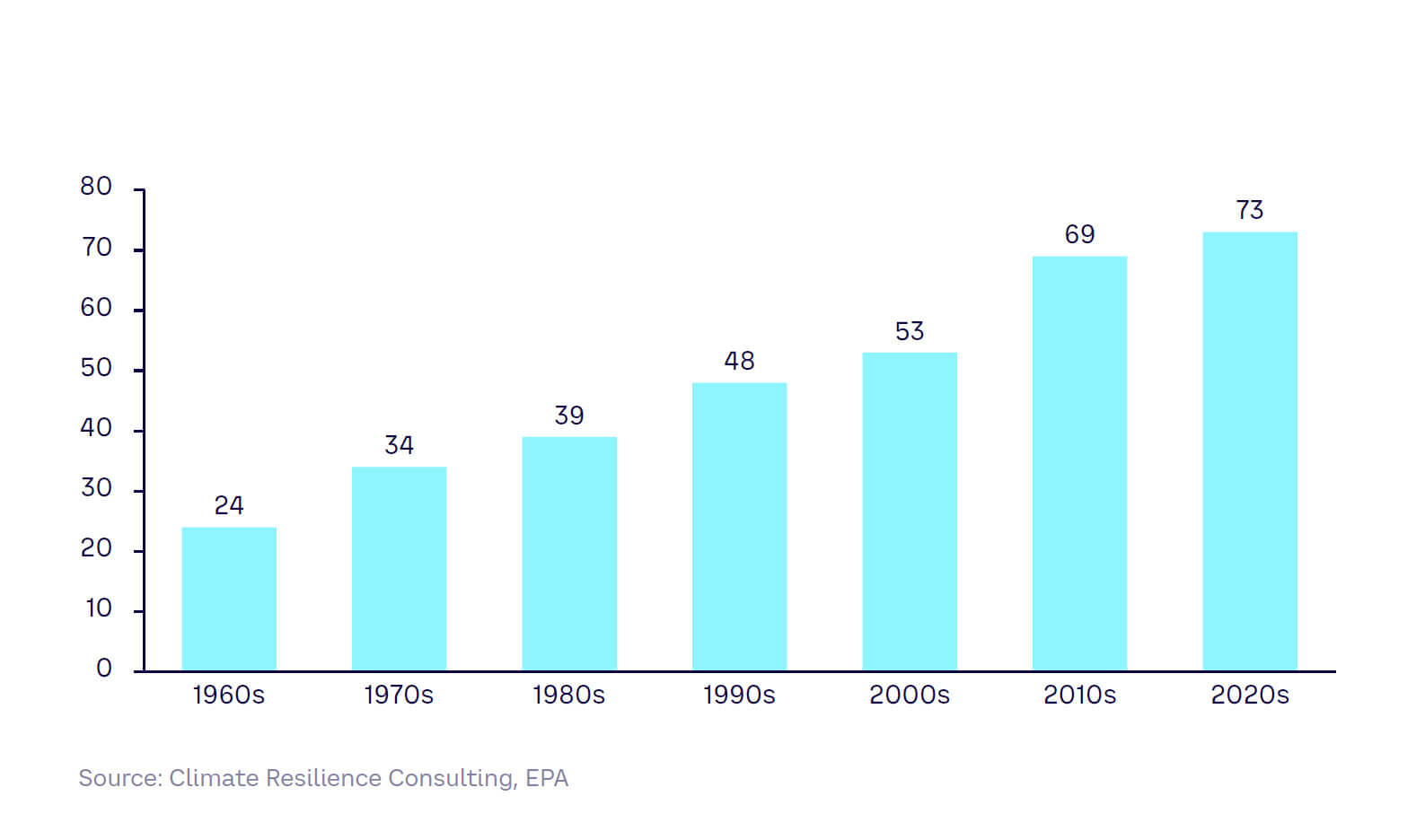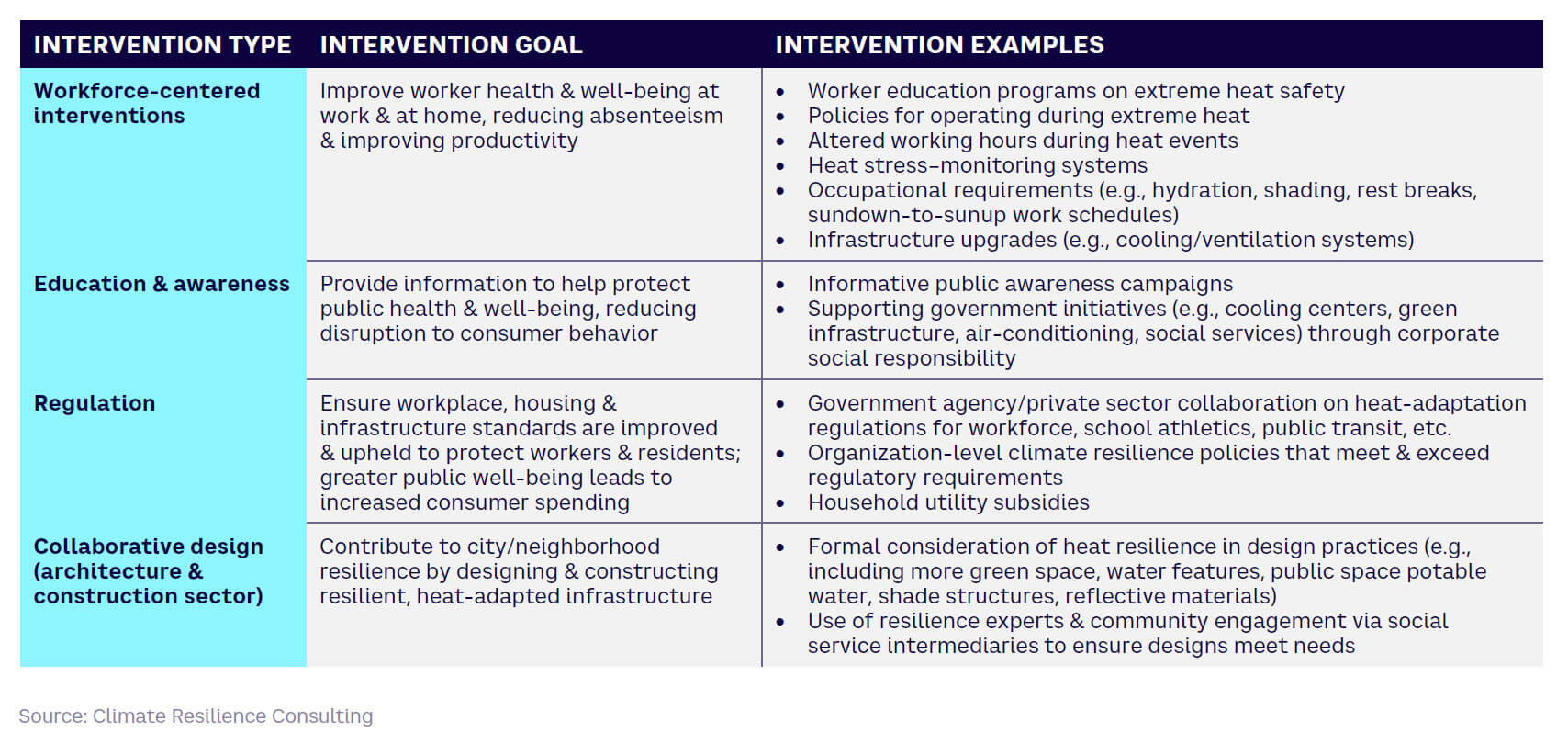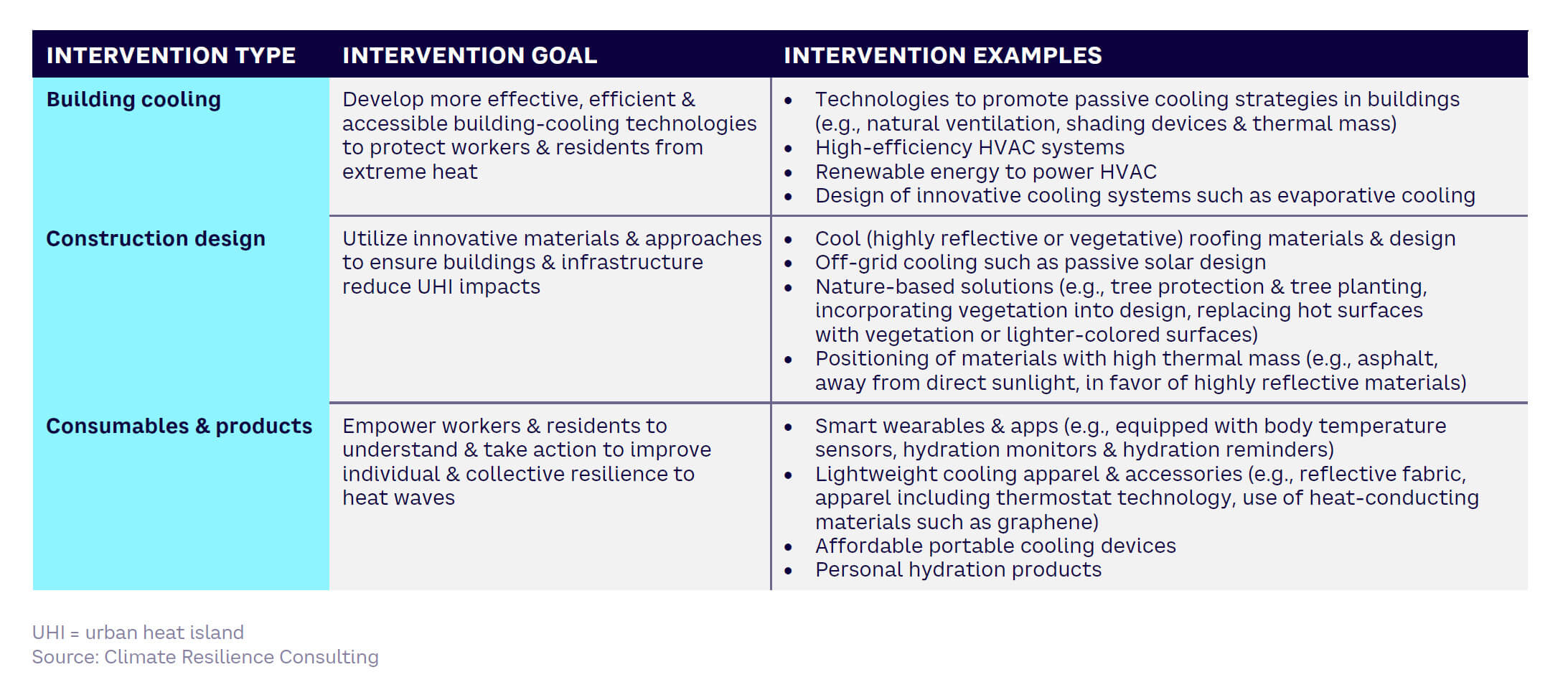
Globally, numerous studies have shown that exposure to extreme heat results in more deaths than any other climate-related hazard, and the impacts are increasing. Rising global temperatures, primarily caused by climate change due to GHG gas emissions, are leading to more frequent and severe heat waves. Alongside the impact on human health, heat waves also affect economies and infrastructure and can compound other climate and non-climate risks, such as drought and wildfires.
2023 was the hottest year on record thus far, rising to 1.5°C (above preindustrial averages). Multiple heat waves were recorded in every continent, and more than 80% of the global population experienced heat that was amplified at least threefold by climate change.[24]
The threat of extreme heat will continue to increase. In India, by 2030 under a high-impact (RCP 8.5) climate change scenario, between 160-200 million people could live in regions with a 5% average annual probability of experiencing a deadly heat wave that exceeds the “survivability threshold” for a healthy human being.[25] This “wet bulb” temperature threshold of 35°C (95°F) was close to being met in multiple cities in 2023 and has already been exceeded in some areas of Pakistan and the Gulf region.[26]
In the US, extreme heat events are lasting longer and becoming more frequent and intense. Additionally, the extreme heat season is also lasting longer, meaning more places are experiencing heat that impacts both indoor and outdoor situations. Figure 16 shows that the average annual length of the heat wave season in the US increased by over 200% between the 1960s and 2020s.

Disproportionate vulnerability
Extreme heat’s impacts on human health and the economy are unequal and depend on vulnerability and exposure. The regions most vulnerable to extreme heat are in low-latitude and low- and middleincome countries with a greater proportion of outdoor workers. However, few areas are immune to the impacts of extreme heat, as demonstrated by deadly heat waves in Europe (in 2003, 2019, and 2023), Russia (in 2010), and most recently in the Southwestern US in 2023.
Exposure
While extreme heat can occur in most populated areas, the intensity is accentuated in urban areas, with dense populations and economic activity. The “urban heat island” (UHI) effect magnifies ambient temperatures due to buildings and built surfaces absorbing and retaining heat in densely developed areas. People living and working in highly built-up areas experience increased exposure to extreme heat for longer.
Where people work is an additional factor for exposure to extreme heat; physically active people who work outside in environments without access to shade and cooling have greater exposure. The same is true for people who work in indoor industrial facilities without adequate cooling. Heat exposure can also occur outside of work hours. For instance, commuters required to wait in unshaded and hot environments or transits without adequate cooling have increased exposure, as do those who live in places without adequate cooling. The combination of exposure to heat in commuting and/ or living environments increases overall exposure, since the human body needs time to cool down during a 24-hour period.
Vulnerability
The impact of extreme heat on an individual is highly variable, with some groups being more vulnerable, including people with chronic diseases, older people and the very young, low-income individuals, underserved populations, people living alone, pregnant women, and unhoused people. Risk to extreme heat is a function of exposure and vulnerability. In areas with high vulnerability (e.g., underserved, lower-income populations in large urban areas) and high exposure (e.g., heavily built-up areas with low levels of vegetation cover), people are at greater risk of illness and death due to extreme heat.
Health, labor & transportation impacts
Extreme heat exposes populations to multiple negative outcomes, impacting health, the workforce, productivity, and transportation.
Health
Exposure to heat can have severe impacts (e.g., heat exhaustion and heat stroke). Impacts on health vary significantly, with socially vulnerable groups living in underinvested areas being much more at risk.
In extreme heat events, emergency services become stretched. Heat wave events increase ambulance callouts, leading to slower response times for all medical emergencies. This has the greatest impact on people with underlying health conditions and those living in underserved areas where resources are already stretched. Studies in European cities showed that for every degree Celsius increase over the heat wave threshold, overall mortality increased by between 2.9% and 5.5%.[27]
Access to air-conditioning is a critical mitigant of health risks from heat. As extreme heat events become more common, greater strain is placed on electricity grid networks and can risk outages, which further increase exposure to heat. Without adaptations to urban and living environments, extreme heat–related deaths in the US alone could increase more than sixfold, to more than 59,000 heatrelated deaths per year by 2050.[28]
Labor productivity
Extreme heat reduces productivity in the workforce. It is more difficult to engage in physical activity in extreme heat, with human work capacity decreasing between 22%-66% at 37.5°C, depending on the humidity.[29] Extreme heat also reduces productivity by increasing absenteeism, modifying consumer behavior, and impacting transport infrastructure. Productivity losses are steepest in outdoor work sectors, such as agriculture and construction, but are greatest overall in the service sector.[30] For instance, even exposure to temperatures above ~30°C (85°F) leads to US workers reducing their workdays by an average of one hour.[31]
Exposure to working temperatures above 35°C (95°F) is known to cause workers to work more slowly and make more mistakes. Hot days increase occupational injuries in outdoor and indoor activities. In the US, extreme heat events explain around 120,000 occupational injuries on average per year. Without adaptation, this number could increase nearly fourfold to ~450,000/year.[32]
At a global scale, by 2060, given climate change impacts, global economic losses from extreme heat could reach up to 4.6% of GDP, with these losses attributed to health (37%-45%), labor-productivity loss (18%-37%), and indirect loss from supply chain disruption (12%- 43%).[33] Losses from health and labor productivity will be greatest in small- and medium-sized developing countries in South-Central and West Africa and Southeast Asia. Supply chain disruption is more widespread and will hit manufacturing-heavy countries like the US and China.
Extreme heat events already cause huge disruptions to supply chains, which lead to delays in production and distribution, impacting the timely delivery of goods and services to customers and affecting revenue streams and overall business operations. Even single extreme heat events can have global impacts. For example, in China’s 2022 heat wave, power shortfalls and extreme heat caused even globally important manufacturers to suspend operations, causing disruptions and delays to global supply chains.
Transportation
Extreme heat can wreak havoc on transport infrastructure, posing significant challenges to road, rail, and air travel. It can cause damage to asphalt roads and runways, vehicle overheating, buckled rails, an increased risk of fire, and sagging overhead cables along rail infrastructure. Additionally, heat waves can strain air travel operations, as high temperatures reduce aircraft lift, necessitating weight restrictions and potentially leading to flight cancellations or delays. These impacts are especially profound in places used to moderate climates, such as Europe, and highlight the need for adaptation of new materials, technologies, and practices.
Compounding impacts
Extreme heat can compound or even instigate other climate-related risk events. For instance, the vast wildfires in Canada in June 2023 were exacerbated by extreme heat and impacted air quality across swathes of the Midwestern and Northeastern US.
In especially vulnerable regions such as Sub-Saharan Africa, there is some evidence that hotter climatic conditions can exacerbate the risk of conflict in low-income regions heavily dependent on agriculture. However, the causal pathways of climate change impacts on conflict and migration are extremely complex and situationally dependent.
Resilience opportunity
Creating resilience in economies and communities is a necessity, but it is also an opportunity. Heat resilience stands as a pivotal opportunity for global corporations and organizations of all sizes to innovate and help society adapt. There are multiple measures that can be implemented to adapt to extreme heat, each of which presents opportunities to create new products, improve existing products and practices, and work in new fields. Essentially these opportunities fall into two categories: strategy and technology.
Strategic
Adaptation opportunities are varied and can be implemented at different scales by most businesses and organizations. From a business perspective, they can be viewed as measures which enable them to improve worker productivity, influence consumer spending, and improve health and well-being in communities. We share a selection of strategic opportunities in Table 8.

Technology
The need to change and/or improve existing products and services to better protect workers and communities from extreme heat presents technology-focused opportunities. While heat-adaptation measures like air-conditioning have been available for some time, they need reforming and enhancing to make them more effective, energy-efficient, and accessible (i.e., more affordable) to communities.
Businesses, particularly those in the energy, construction, and electrical goods sectors, can play a huge part in providing these solutions, bringing turnover and revenue benefits to those who innovate successfully. Table 9 provides examples of where private sector innovation could benefit heat resilience.
Conclusion
Extreme heat increases morbidity and mortality, reduces productivity, and disrupts global supply chains. There are, however, many actions that companies can take to mitigate and adapt to these impacts. Companies that act now will face lower disruption and create new opportunities in the face of increasing global temperatures. Extreme heat mitigation and adaptation can lead to innovation that benefits society and brand image and should be prioritized by forward-looking risk, innovation, and finance officers.

Joyce Coffee, LEED AP, is founder and President of Climate Resilience Consulting, a certified WBE (Women Business Enterprise) that works with clients to create practical strategies that enhance markets and communities through adaptation to climate change. She is a resilience pioneer, having worked for over 200 clients to create and implement climate-related strategies, build partnerships, and direct collaborative implementation of complex initiatives. Ms. Coffee is an appointed director or chair of over 20 international or national nonprofit boards and initiatives related to resilience and social equity, including the Anthropocene Alliance. She has 25 years’ experience in every major sector, including leadership roles in city government and the private, nonprofit, philanthropic, and academic sectors.
Robert Macnee is Deputy Director of Resilience Services at Climate Resilience Consulting. He is a highly trained climate impact expert with a PhD in environmental management focused on extreme heat impacts on health and communities and has six years’ experience in economic development and equitably building resilience in communities. Mr. Macnee brings his knowledge and experience to clients through stakeholder and community engagement, providing training, supporting partnership building, and developing resilience strategies. His work focuses on helping communities, governments, and corporations avoid, prepare for, and resist the global and local impacts of climate change.
Endnotes
- Bruton, Michelle. “How the Ski and Snowboard Industry Is Changing in 2022 (and What Comes Next).” Forbes, 27 April 2022.
- See sidebar in Chapter 3 for more details on the “+3°C by 2100” trajectory.
- Buchner, Barbara, et al. “Global Landscape of Climate Finance 2021.” Climate Policy Initiative (CPI), 14 December 2021.
- Lee, H., and J. Romero (eds.). “Climate Change 2023: Synthesis Report. Contribution of Working Groups I, II, and III to the Sixth Assessment Report of the Intergovernmental Panel on Climate Change.” IPCC, 2023.
- Gray, Jennifer. “The Most Devastating Hurricanes Could Double by 2050 in Nearly All Regions of World, Scientists Say.” CNN, 27 April 2022.
- Lee, H., and J. Romero (eds.). “Climate Change 2023: Synthesis Report. Contribution of Working Groups I, II, and III to the Sixth Assessment Report of the Intergovernmental Panel on Climate Change.” IPCC, 2023.
- Igini, Martina. “Up to 47% of Amazon Rainforest at Risk of Collapse by Mid-Century Due to ‘Unprecedented Stress’ from Global Warming and Deforestation.” Earth.Org, 15 February 2024.
- Cammalleri, C., et al. “Global Warming and Drought Impacts in the EU: JRC PESETA IV Project — Task 7.” European Commission Joint Research Centre (JRC), 2020.
- Panagos, Panos, et al. “Global Rainfall Erosivity Projections for 2050 and 2070.” Journal of Hydrology, Vol. 610, July 2022.
- “Climate Change Hazard Ratings for New York, NY.” ClimateCheck, accessed June 2024.
- “Global Water Security and Sanitation Partnership: Annual Report 2023.” The World Bank, accessed June 2024.
- Kuzma, Samantha, et al. “Aqueduct 4.0: Updated Decision-Relevant Global Water Risk Indicators.” World Resources Institute, 16 August 2023.
- “Bangladesh: A Country Underwater, a Culture on the Move.” Natural Resources Defense Council (NRDC), 13 September 2018.
- Jägermeyr, Jonas, et al. “Climate Impacts on Global Agriculture Emerge Earlier in New Generation of Climate and Crop Models.” Nature Food, Vol. 2, November 2021.
- Schneider, Léonard, et al. “The Effect of Climate Change on Invasive Crop Pests Across Biomes.” Current Opinion in Insect Science, Vol. 50, April 2022.
- Semenza, Jan C., et al. “Climate Change Projections of West Nile Virus Infections in Europe: Implications for Blood Safety Practices.” Environmental Health, Vol. 15, Supplement 1, March 2016.
- Bernstein, Asaf, et al. “Disaster on the Horizon: The Price Effect of Sea Level Rise.” Journal of Financial Economics, Vol. 134, No. 2, November 2019.
- Evans, Hayleigh. “‘You Don’t Have to Shovel Sunshine’: Amid Heat Waves, Why Do People Still Move to Phoenix?” Arizona Republic, 3 November 2023.
- Clement, Viviane, et al. “Groundswell Part II: Acting on Internal Climate Migration.” Climate Diplomacy, 14 September 2021.
- Buchner, Barbara, et al. “Global Landscape of Climate Finance 2023.” Climate Policy Initiative, 2 November 2023.
- Tandon, Ayesha. “Drought Behind Panama Canal’s 2023 Shipping Disruption ‘Unlikely’ without El Niño.” Carbon Brief, 1 May 2024.
- For more on digital twins, see: Meige, Albert, et al. “The Industrial Metaverse.” ADL Blue Shift Report, July 2023.
- “State and Trends in Climate Adaptation Finance 2023.” Climate Policy Initiative/Global Center on Adaptation, 2024.
- Igini, Martina. “More than 80% of People on Earth Experienced a Hotter July Triggered by Climate Change: Report.” Earth.Org, 4 August 2023.
- Woetzel, Lola, et al. “Climate Risk and Response: Physical Hazards and Socioeconomic Impacts.” McKinsey Global Institute, 16 January 2020.
- “Wet bulb” is a measure of heat-stress conditions on humans, combining dry air temperature with humidity. A wet bulb temperature of 35°C (95°F) is equivalent to a regular ambient temperature measure of 71°C (nearly 160°F).
- Sapari, Hadita, et al. “The Impact of Heat Waves on Health Care Services in Low- or Middle-Income Countries: Protocol for a Systemic Review.” JMIR Research Protocols, Vol. 12, October 2023.
- Arsht, Adrienne. “Extreme Heat: The Economic and Social Consequences for the United States.” Atlantic Council, 31 August 2021.
- Foster, Josh, et al. “An Advanced Empirical Model for Quantifying the Impact of Heat and Climate Change on Human Physical Work Capacity.” International Journal of Biometeorology, Vol. 65, March 2021.
- Arsht, Adrienne. “Extreme Heat: The Economic and Social Consequences for the United States.” Atlantic Council, 31 August 2021.
- Cerullo, Megan. “Extreme Heat Costs the US $100 Billion a Year, Researchers Say.” MSN.com, accessed May 2024.
- Arsht, Adrienne. “Extreme Heat: The Economic and Social Consequences for the United States.” Atlantic Council, 31 August 2021.
- Sun, Yida, et al. “Global Supply Chains Amplify Economic Costs of Future Extreme Heat Risk.” Nature, Vol. 627, March 2024.
“The era of procrastination, of half-measures, of soothing and baffling expedients, of delays, is coming to its close. In its place, we are entering a period of consequences.” — Winston S. Churchill
